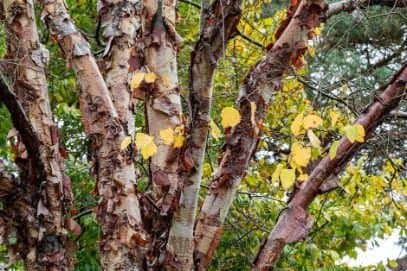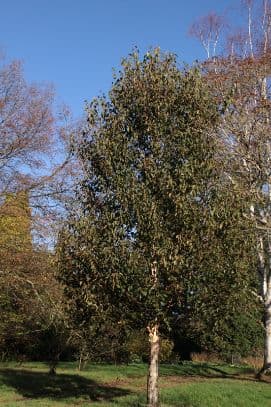Schmidt Birch Betula schmidtii

ABOUT
Betula schmidtii, commonly known as Schmidt birch, is a visually striking plant adorned with distinctive attributes, setting it apart from other species in its genus. The plant showcases a beautiful exfoliating bark that often incorporates shades of white, gray, and sometimes a hint of orange or brown, providing a textured and multicolored appearance that becomes more pronounced as the plant matures. This exfoliating characteristic is often sought after for ornamental purposes as it adds year-round interest to gardens and landscapes. The leaves of the Schmidt birch are typically small to medium in size, with a somewhat triangular or broadly ovate shape, showcasing pointed tips and a subtly serrated or toothed margin that gives them a delicate and intricate outline. The foliage embodies a bright green hue during the growing season, which transitions into a stunning display of yellow in the autumn months, heralding the change of seasons with a splash of warm color. In spring, the plant bears modest catkins that dangle elegantly from the branches. These catkins, which are the flowering structures, contribute additional visual interest with their elongated and slender form. While not overly showy, they imbue the plant with a gentle grace as they sway in the breeze. The overall structure of the Schmidt birch is often noted for its attractive silhouette, with branches that can be upright or slightly spreading, giving it a balanced and aesthetically pleasing form that can serve as a focal point in various landscape designs. The combination of its peeling bark, elegant leaves, and charming catkins makes the Schmidt birch a beloved choice for those looking to add texture, color, and year-round beauty to their outdoor spaces.
About this plant
 Names
NamesFamily
Betulaceae
Synonyms
Schmidt's Birch
Common names
Betula schmidtii.
 Toxicity
ToxicityTo humans
Betula schmidtii, commonly known as the Schmidt's birch, is not generally known to be toxic to humans. Most species of birch are not poisonous and are actually used in traditional medicine in various cultures. However, it's always wise to be cautious with plants not intended for consumption, as individual allergies or sensitivities could potentially cause reactions.
To pets
Schmidt's birch, the common name of Betula schmidtii, is not typically toxic to pets. Birch trees are generally considered non-toxic to dogs, cats, and horses. As with humans, pets may have individual sensitivities, and ingestion of non-food items can result in gastrointestinal upset. Always monitor your pet's health and consult a veterinarian if you observe any unusual symptoms after ingestion of plant material.
 Characteristics
CharacteristicsLife cycle
Perennials
Foliage type
Deciduous
Color of leaves
Green
Height
20 feet (6 meters)
Spread
15 feet (4.5 meters)
Plant type
Tree
Hardiness zones
5
Native area
Russia
Benefits
 General Benefits
General Benefits- Erosion Control: Betula schmidtii helps in stabilizing the soil and preventing erosion with its root system.
- Wildlife Habitat: It provides shelter and food for various bird species, insects, and small mammals.
- Aesthetic Appeal: With its attractive bark and foliage, it adds beauty to landscapes and gardens.
- Shade Provision: Its canopy can offer shade for underplantings and relief from the sun during warmer months.
- Climate Resilience: It is typically resilient to cold temperatures, making it suitable for northern climates.
- Wood Production: The wood of Betula schmidtii is useful for various carpentry and craft projects.
- Environmental Indicator: The presence of this plant can indicate certain soil and climate conditions in its natural habitat.
- Diversity in Landscaping: It adds variety to plantings with its unique characteristics compared to other trees and shrubs.
 Medical Properties
Medical PropertiesThis plant is not used for medical purposes.
 Air-purifying Qualities
Air-purifying QualitiesThis plant is not specifically known for air purifying qualities.
 Other Uses
Other Uses- Art and Craft Material: The wood of the Schmidt birch can be used in the production of small handcrafted items or carvings, notable for its fine grain and workability.
- Landscaping: Due to its attractive bark and foliage, Betula schmidtii is often planted as an ornamental tree in gardens and parks.
- Furniture Making: The wood is sometimes used for crafting furniture, particularly rustic or outdoor pieces that benefit from the wood's durability.
- Photographic Subject: The striking white bark of the Schmidt birch makes it a popular subject for nature photographers and artists seeking to capture its unique texture and form.
- Environmental Education: This species is used in educational settings to teach about boreal forest ecosystems and the importance of plant diversity.
- Winter Interest: In gardens with a winter season, the white peeling bark and distinct silhouette of the Schmidt birch provides visual interest in the otherwise bare landscape.
- Windbreaks: These trees can be planted in rows to act as windbreaks that protect smaller plants and reduce soil erosion.
- Woodworking Projects: The timber from Betula schmidtii is suitable for various woodworking projects, including turning on a lathe to create wooden bowls and spindles.
- Bonsai: With proper care and technique, the Schmidt birch can be cultivated as a bonsai, appealing to enthusiasts of this miniature art form.
- Dye Production: The bark and leaves of Betula schmidtii can be used to create natural dyes for textiles, yielding colors that vary based on the mordant used.
Interesting Facts
 Feng Shui
Feng ShuiThe plant Betula schmidtii, commonly known as Schmidt's birch, is not used in Feng Shui practice.
 Zodiac Sign Compitability
Zodiac Sign CompitabilitySchmidt's birch is not used in astrology practice.
 Plant Symbolism
Plant Symbolism- Adaptability: Betula schmidtii, commonly known as Schmidt birch, often symbolizes adaptability due to its ability to thrive in various soil conditions and withstand cold climates.
- Renewal: The Schmidt birch is associated with renewal because birch trees are often among the first to repopulate areas disturbed by natural events, representing new beginnings and hope.
- Purification: Birch trees, in general, have been linked to purification and cleansing, as their sap has detoxifying properties and their presence in a landscape often indicates a clean environment.
- Protection: In some cultures, birch trees are seen as protective spirits. Schmidt birch may inherit this symbolism, offering a sense of safeguarding against negative energies.
 Water
WaterSchmidt's Birch prefers consistently moist soil, but it is essential to avoid waterlogging. Water young trees with 1 to 2 gallons once a week, particularly during dry spells. Increase the amount as the tree matures, aiming for a similar rate but scaled to the tree's size, ensuring the surrounding soil is moist to the touch but not saturated. During hot, dry periods, additional watering may be necessary to keep the soil moist, whereas less frequent watering is needed in cooler, wetter conditions. Always water the tree slowly at the base, allowing for deep soaking and strong root development.
 Light
LightSchmidt's Birch thrives best in full sunlight or partial shade. The ideal location is a spot where the tree can receive at least six hours of direct light every day. However, in particularly hot climates, some afternoon shade is beneficial to avoid scorching the leaves.
 Temperature
TemperatureSchmidt's Birch is hardy and can tolerate a range of temperatures; however, it grows best in conditions where the temperature is between 40°F and 75°F. The tree can survive minimum winter temperatures down to -30°F and maximum summer temperatures up to 85°F. Avoid planting in areas where extreme temperatures are frequent, as they can stress the tree and cause damage.
 Pruning
PruningPrune Schmidt's Birch primarily to remove dead, damaged, or diseased branches and to maintain its shape. The best time for pruning is late fall to early spring when the tree is dormant. Light pruning can be done annually, but major structural pruning should be done every three to five years. Always use clean, sharp tools to make clean cuts and minimize stress to the tree.
 Cleaning
CleaningAs needed
 Soil
SoilSchmidt's birch prefers well-drained, moist soil with a mix of loam, sand, and some organic matter. Aim for a slightly acidic to neutral pH between 5.5 and 7. A common recipe includes one-third loam, one-third sand, and one-third peat or compost for added nutrients.
 Repotting
RepottingSchmidt's birch generally does not require frequent repotting as it is typically grown as an outdoor tree. Repotting young trees can be done every two to three years to encourage growth. Mature Schmidt's birch trees do not need to be repotted.
 Humidity & Misting
Humidity & MistingSchmidt's birch prefers moderate to high humidity levels, but being adaptable, it can tolerate a range of conditions. Best growth is observed in regions where the average humidity stays within 40-60%.
 Suitable locations
Suitable locationsIndoor
Grow Schmidt's birch indoors with bright light and good air circulation.
Outdoor
Plant Schmidt's birch in full sun to partial shade with proper soil drainage.
Hardiness zone
4-7 USDA
 Life cycle
Life cycleBetula schmidtii, commonly known as Schmidt's Birch, follows a typical angiosperm life cycle, beginning with seed germination, where the embryo emerges from the seed as a seedling. The seedling then undergoes vegetative growth, developing a root system and foliage as a sapling. The sapling matures into an adult tree with a woody trunk, capable of photosynthesis and further growth. Once mature, the Schmidt's Birch produces flowers, with separate male and female catkins on the same tree, a process known as monoecy. Pollination occurs typically via wind, leading to the production of seeds within small cones. The life cycle completes when these seeds are dispersed, usually by wind or animals, and find suitable conditions to germinate, beginning a new generation.
 Propogation
PropogationPropogation time
Spring
The most popular method of propagating Betula schmidtii, commonly known as Schmidt's Birch, is by seed. To propagate by seed, collect the seeds in fall when the cones disintegrate and release them. Clean the seeds of any husk or debris, then subject them to cold stratification, which mimics winter conditions. This process requires placing the seeds in a moist medium like sand or peat mixed with a little water, then storing them in a refrigerator at a temperature of 34 to 41 degrees Fahrenheit (1 to 5 degrees Celsius) for about 60 to 90 days. After stratification, sow the seeds in well-drained soil in a sunny to partially shaded location. Cover them lightly with soil, as birch seeds need light to germinate. Keep the soil moist but not waterlogged and expect germination in the spring if sown outdoors, or within a few weeks if sown indoors under controlled conditions.





![Silver birch [Fastigiata Joes]](/_next/image?url=https%3A%2F%2Fplants-admin.emdemapps.com%2Fimages%2Fplants%2F%2Fimages%2F604b6438424d4.png&w=640&q=75)



